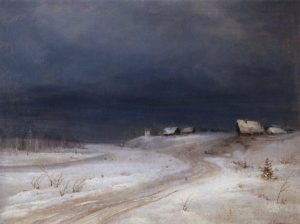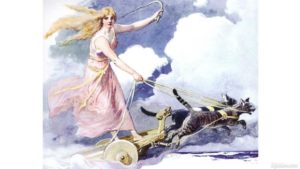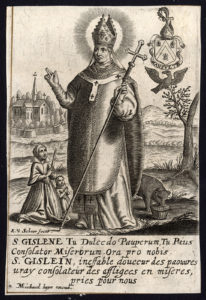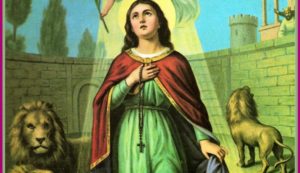
The name Ailbe is derived from the Irish words ail (rock) and beo (alive). Ailbe itself was the name of a divine war dog guarding the boundaries of Leinster.
Ailbe was born to a maidservant in the house of Cronan, Lord of Eliach in County Tipperary. Cronan, for reasons unknown, disapproved of his birth and ordered the baby exposed to “dogs and wild beasts, that he might be devoured.” But, instead, the boy was hidden under a rock where he was found and nursed by a she-wolf. The wolf raised him with her own cubs.
Long afterwards, when Ailbe was a bishop, an old she-wolf being pursued by a hunting party ran to the bishop and laid her head upon his breast. Ailbe ordered the hunters not to harm her. Ailbe protected the wolf, and every day she would come to his hall to eat with him.

The folklore surrounding December 13th has held a special place in Norway since the Viking Age. It was thought to be the longest night of the year and the beginning of the Yule season. It was a dangerous night, since it was ruled by a female spirit, a vette or vaettir, called Lussi (“Light”). She was the mother or leader of the vettir (spirits) and other Huldrefolk (supernatural beings), and kin to Huldra (forest spirits), the nisse (gnomes), trolls, and even to the Norse gods. Lussi is associated with the Asgardsrei, the Riders from Asgard; the Julereia, the Yule Riders, and the Wild Hunt, who are said to appear on this night. People did not want to be outside when they went past, because folk legends told of people being snatched up and carried away to some faraway place. Other unwary travelers disappeared forever.
Part of Lussi’s spiritual task was to make sure people completed their chores before the Yule season, which was a holy time when people were not supposed to work. If the work didn’t look like it would be done, the household could have gotten some form of punishment from an angry Lussi. Everything had to be done by December 13th, especially spinning, brewing beer and ale, cleaning, taking care of the animals—domestic and wild–threshing, slaughtering, and baking. Special cakes needed to be made. These cakes, called “Lussi-cats” (Lussekatter) are baked with saffron, an imported spice that’s a yellow color, symbolizing gold, light, sun—all associated with both the goddess Freya and Lussi. The cakes are formed like two spirals, and a raisin or other dry fruit would serve to give the impression of cat’s eyes, or sight in the dark. They were also ancient Nordic circular symbols of the sun. It was important to have these cakes ready for Lussi, and they were eaten by everyone in the household. 
This was also the night when animals would gossip, and talk to one another about how the people treated them in the past year. If someone had mistreated or abused any animal, vengeance would come from Lussi and her retinue of spirits! So the barn and stable had to be clean and comfortable, and the livestock given an extra treat of food, or a Lussibit, so they would give her a favorable report.
Over the centuries, as Christianity became more and more assimilated into Norwegian culture, “Lussi” became “Lucia” a saint whose name also means “light.” The celebration of St. Lucia, and the household or town processions, are now linked with the Winter Solstice, the darkest night of the year. The young woman representing St. Lucia symbolizes the bringer of light to the dark. She wears a candled wreath, which was traditionally worn as a crown decorated with evergreen lingonberry branches. She is accompanied by young girls as her handmaidens, dressed in white and holding candles. The morning of St. Lucia Day the oldest daughter of the household brings her parents and siblings coffee and pastries for breakfast. These saffron-spiced cakes are called St. Lucia Buns, or Lussekatter. 
I was trying to imagine Lussi Long-Night and St. Lucia celebrations by my own ancestors in Norway in the 18th and 19th centuries and earlier. Living on farms, they experienced the long dark nights of winter. Pitch darkness can be very scary, and quickly becomes the domain of monsters and evil. The members of the household must kept busy indoors tending the fire, eating, drinking, sewing and telling stories. On the longest night, in her role as light bringer, the eldest daughter might have led a procession from the house to the stabbur (storage house), barn and stable, and around the boundaries of the farmstead to protect it from evil. In earlier times invocations may have been to Freya, a goddess associated with love, warfare, magic, death, gold, and cats. In the last two centuries St. Lucia has held sway, but I can still feel Freya and Lussi in the night.

Saint Ghislain (died October 9, 680) was a confessor and hermit in Belgium. He lived during the reign of King Dagobert I (605-639 A.D.), King of the Franks and one of the last great kings of the Merovingian dynasty.
The name of Ghislain comes from the Germanic words gisal, “hostage,” and lind “sweet.” St. Ghislain is frequently portrayed with a bear or bear cub beside him. According to legend, King Dagobert was out hunting in a forest and was chasing a bear. She sought refuge with Ghislain and he protected her from the hunting party. The bear later showed Ghislain the place where he should establish a monastery.
The legend is sweetly told in the 1854 article, “A Few Words About Bears,” by S. French in an 1854 edition if the New York Journal of Romance, General Literature, Science and Art.
“One day, as King Dagobert, who reigned over France and Belgium, was hunting in the forests of Hainault, he strayed from his company in the pursuit of a large bear, which, knowing what it was about, sought refuge in the hermitage of Saint Ghislain. The saint was at his devotions, and did not look around. The bear squatted beside a basket, in which the hermit left his sacerdotal ornaments. Soon after, King Dagobert entered the hermitage, and was not a little startled and surprised to see the monstrous animal lying at the feet of an old man engaged in prayer.”
“Saint Ghislain turned at the noise made by the prince’s entrance. He then perceived what had occurred, and begged the life of the bear. Dagobert immediately recognized the man of God, whose name was celebrated throughout the country, and accorded him that which he had solicited; and after embracing him, and praying him to rely upon him for countenance and support, he retired and left the Saint with his bear. “
“No sooner had the King departed than the bear arose, took up the basket with its contents, and, laden with this precious burden, fled away towards the place where she had left her young. She knew that by so doing she would be able to draw thither the hermit who protected her. The spot was a charm and picturesque one, afterwards called Ursidong or the Bears Grove, situated in the forest on the border of the river Haine, which has given its name to Hainault.” 
“As the bear calculated, Ghislain followed her; but, impelled by a desire to join her little ones, she went so fast that the Saint in a very short time lost sight of her. He found himself bewildered in the midst of the vast forest, where the foot of man had never yet traced a path, when an eagle appeared before him, fluttering to attract his attention. Ghislain, seeing something extraordinary in all of this, suffered himself to be guided by the eagle, and presently arrived at the Grove of the Bear.”
“This spot he found to be so attractive and convenient, that he transported thither his dwelling. His new friends, the eagle and the bear, never quitted him. Numerous anchorites, drawn by reports of these marvels, came and placed themselves under the discipline of the saint. They built a grand monastery, around which, in the process of time, grew a town, which was called Saint Ghislain.”
“Up to the end of the last century, when the monastery was suppressed, an eagle and a she bear were constantly kept there, in memory of the saint who died in 670.”

A healthy number of saints’ stories feature people who were “called to chastity” or to a relationship with Christ vs. marriage. All kinds of fantastic legends and tales ensued about the lengths to which these people would go to avoid marriage and connubial sex. Ultimately, they were all successful in their quest to avoid sex with members of the opposite sex. They ended up living alone (rarely) or with a same-sex companion (often) or same-sex community in a wilderness setting (usually).
St. Thecla the Evangelist is one of those saints. She would face anything but marriage.
Thecla’s story is preserved in the Acts of Paul and Thecla, an apocryphal story of Paul’s impact on a young virgin, Thecla, and her subsequent trials, adventures and spiritual leadership as his disciple. She infuriated many Church Fathers, including Tertullian, who griped that some Christians were using the example of Thecla to legitimize women’s roles in teaching and baptizing.
According to Acts, Thecla was a beautiful young woman of Iconium (now Konya, Turkey) whose life was transformed when she heard St. Paul preaching in the street beneath her window. She announced her intention to break off her engagement and to embrace a life of chastity. Her finance was furious. Her family was scandalized. They denounced her to the governor who had her arrested and condemned to death. Thecla was tied naked to a stake, but a miraculous thunderstorm put out the flames. She is saved. Once home, Thecla disguises herself as a youth and escapes to reunite with Paul and travel to Antioch.
While traveling, she is sexually assaulted by Alexander, a prominent man of Antioch. One account reads: “Repulsing the assault, she tears his cloak and knocks the wreath from his head. Alexander (the would-be ravisher) brings her before the magistrate who, despite the protests of the women of the city, again condemns Thecla to death, this time ad bestias. Pleading to remain a virgin until her death, she is taken in by ‘a certain rich queen, Tryphaena by name,” who lost her own daughter. (Tryphaena was the widow of Cotys, King of Thrace and a great-niece of the Emperor Claudius. In Romans 16:12, Paul sends greetings to a Tryphaena.) 
Thecla is allowed to return to Tryphaena. She rides a lioness (who licks her feet) and is paraded through the city. The next morning, Alexander comes for her and escorts her to the arena to die. There she is stripped and thrown to wild beasts. A lioness (presumably the one who licked her feet) protects her from the attacks of lions, bulls and bears. Thecla prays, and throws herself into a trench of water (an euripus) and baptizes herself. The water is full of ferocious and hungry seals. A cloud of fire covers her nakedness and kills the vicious seals. The women in the stands of the arena cast fragrant nard and balsam into the area, which had a pacifying effect on the remaining wild animals. The awestruck governor releases Thecla and she returns to the palace of Queen Tryphaena. Refusing all entreaties to stay with the queen, Thecla dresses in male clothing and sets out to find Paul. She tells him that she baptized herself, and had been commissioned by Christ to baptize and preach in his name. According to the story, Paul recognized her as a fellow apostle and encouraged her to preach the Gospel. Wherever she went, “a bright cloud conducted her on her journey.”
Thecla encouraged women to live a life of chastity and to follow the word of God. She returned home to find her finance had died and her mother indifferent to her preaching. She left, and in one version of her story, she dwelt in a cave in Seleucia Cilicia (southern Turkey) for 72 years and formed a monastic community of women, whose members she instructed “in the oracles of God.” 
In another version, Thecla passed the rest of her life in a rocky desert cave in the mountains near the town of Ma’aloula (Syria). She became a healer and performed many miracles. She remained persecuted, and men still conspired to rape and kill her. Just as she was about to be seized, Thecla cried out to God for help. A fissure opened in the stone walls of her cave and she disappeared. It is said that she went to Rome and lay down beside Paul’s tomb.
Her cave became an important pilgrimage site in early and medieval Christianity. Today visitors can still see Thecla’s cave and the spring that provided water for her. The nuns who live at the Mar Thecla monastery will tell you her story and show you the opening in the rock where the saint escaped.
There are many wonderful parts of St. Thecla’s story, beginning with her determination to live her life following her calling to evangelize, rather than accede to family or societal expectations. Her protection by animals, the public affirmation by groups of women, are also very positive. She was unashamed of her nakedness when she was led twice to the arena to die. She was proud of her body, her virginity, and her sole possession of it. The biggest surprise was her encouragement by St. Paul ( wives-be-subordinate-to-your-husbands), accepting her as a fellow apostle. The ugly, horrifying constant throughout her life is the desire by men to rape Thecla or kill her if she won’t submit to their authority. Men who are rapists do not believe that they are the problem–females (or males) who aroused them are at fault. What can Christianity do to change this perception?
Saint Kieran was an Irish abbot and bishop who lived in the sixth century. His feast day is March 5. Saint Kieran is said to be the first native-born saint of Ireland. 
His conversion to Christianity probably preceeded the arrival of Saint Patrick. He may have been ordained a bishop during a visit to Rome; or he could be one of the twelve bishops appointed by Saint Patrick.
On his return from Rome Saint Kieran settled in Saighir as a hermit, an area near the Slieve Bloom Mountain range. He wore animal skins and lived in the wilderness. One day, he noticed a fierce looking boar close to him in the forest. Saint Kieran spoke gently to the boar calling him, “Brother Boar.” Kieran loved animals and they trusted him. The boar realized that Kieran was a friend. He helped him build his hut, tearing down strong branches with his teeth and tusks and bringing them to Kieran. Soon, other animals joined them included a wolf, fox, badger, deer, and many birds. Kieran called them his brother monks. The fox stole Kieran’s shoes. The badger went after the fox The animals stayed even though men came to follow to follow Kieran and join his community.
Kieran performed his first miracle as a boy. A kite soared over him and grabbed a little bird as she sat on her nest. Kieran demanded that the kite release the little bird. The kite turned back and released the bird, but it was wounded and half-dead. At Kieran’s command, the little bird was restored to life and resumed sitting on her nest.
In one wonderful tale, Saint Kieran blessed a well and from that time it “had the taste of wine or honey—for everyone who drank from it got drunk as well as filled.” The site may have been a local holy well, which certainly would have become even more popular after his miracle.











